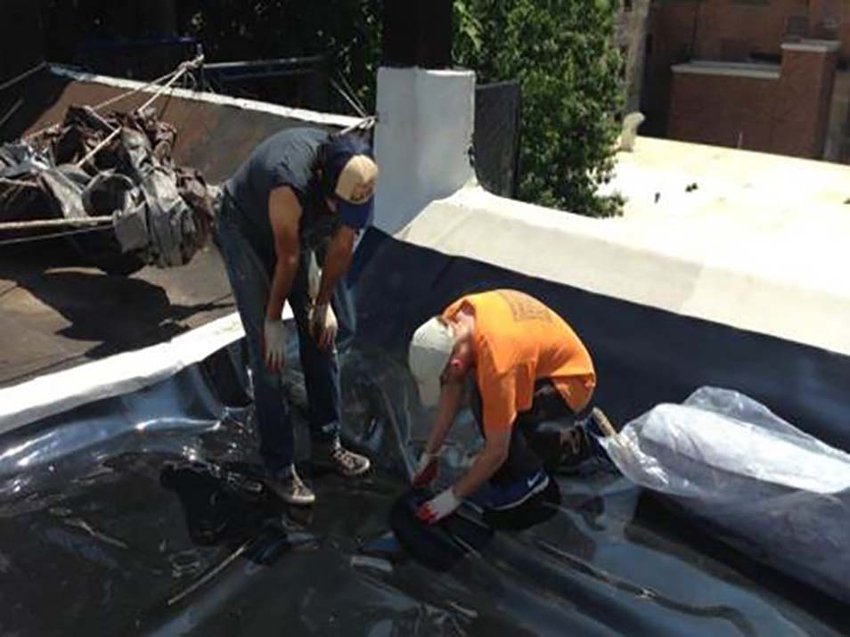Green Roofs: Integrating Blue and Gray
Understanding the Function of a Green Roof
There are two main reasons that people build green roofs: (1) They want to limit rainwater runoff and (2) they want to integrate vegetation into a functional rooftop space.
Rainwater Management
Many areas are governed by regulatory mandates to manage rainwater on site. These regulations are prominent in large, older cities—especially in wet climates—that have combined sewer systems controlling both rainwater runoff and general sewage. Regulations might come from the local level or the U.S. Environmental Protection Agency and generally require that building owners take steps to prevent rainwater from running into the sewer systems unmitigated.
Rainwater management requirements frequently take effect when new construction takes place or substantial renovations are undertaken on an existing building. The solution to rainwater runoff doesn’t necessarily have to be a green roof, but it could be. In San Francisco, for example, there is legislation that requires newly constructed buildings of 10 stories or more have 15–30 percent of their roof space covered by vegetation, solar panels or a combination of both.
In other cases, building owners may simply wish to seek a sustainability accreditation for the property, such as LEED, Living Building Challenge or other certifications. Because of the proliferation of hard, nonporous surfaces in cities, building owners must often look to the roof as their best means of controlling rainwater cost-effectively.
Facing mandates to manage rainwater effectively, building owners often consider green roofs as a means of maximizing water storage capacity by maximizing the vegetative footprint. Plants and soil, after all, can absorb and hold moisture effectively, and the storm surge capacity of a green roof is thus highly dependent on the percentage of vegetative coverage of the roof. The problem, however, is that vegetation may not be the only thing a building owner wants from their rooftop space.
Amenity Space
Especially in dense, urban areas where buildable land is practically nonexistent and air rights can cost hundreds of dollars per square-foot, building owners have a strong incentive to make the most of every inch of space they already possess. Many rooftops are merely cost centers for real estate-strapped property owners, and thus they make an effort to derive value from their rooftops however they can. This may mean creating a multipurpose, multifunctional outdoor amenity space for building occupants. In these cases, the trend is to value human space as much as, if not more than, vegetative space.
The result? Buildings may end up with 10 percent vegetation and 90 percent hard surfaces, whether it’s a wood deck, a swimming pool, pavers or otherwise. The vegetation becomes decoration rather than an effective rainwater management tool. This is a trend not only in residential and hospitality spaces, but also atop schools, hospitals and government buildings as operators seek more ways to leverage existing real estate to accommodate more uses. We see more “gray” and less green.
So, what can be done to balance these conflicting desires for vegetation-driven rainwater management as well as economic value creation? Good news: there is actually an answer. It is possible to accommodate multiple uses and high human capacity across nonvegetated areas of the roof through complex green and “gray” area integration, and extension of water-retaining elements of the green roof into paved areas. It is a concept known as creating a “blue roof.”
Introducing: The Blue Roof
A “blue roof” is any nonvegetative roof system that stores rainwater somewhere on the roof for some period of time. Blue roofs are typically also green roofs, including vegetation in their design somewhere, but they are primarily designed to maximize water storage, no matter how much greenery they possess, by employing water-retention features below the surface of the roof. The water is retained in a drainage layer that is designed to flood, capturing rainwater for access by vegetation or eventual evaporation, rather than allowing it to flow into storm drains.

Figure 4
Every green roofing system includes various layers that help protect the building, retain and control water, and promote growth of vegetation on the surface.
The first thing to know about a water-retaining blue roof is that soil and plant roots are not the only water management agents available to designers. A green roof assembly requires many layers that may or may not be combined into one product. As you can see in Figure 4, there are several basic building blocks of a green roof assembly, and all of these layers will inevitably be included in one way or another. From bottom up, you will see:
- Structural decking
- A waterproof membrane
- A root barrier
- A water-retention layer
- A drainage layer
- A growing medium (i.e., soil)
- Vegetation
Redundancy is critical to good green roof design. The lower layers in the assembly all perform the function for which they are named, but they also serve as an additional barrier between the waterproofing membrane and the soil, which is highly abrasive. Even if a waterproofing membrane is root-resistant, it never hurts to install a root barrier too.
Root Barriers
A root barrier does exactly what it sounds like: it prevents roots from penetrating waterproofing membranes and jeopardizing the building envelope’s integrity. These barriers are typically made of either polyethylene or EPDM. Which one makes the most sense for a given installation depends on the specifics of the application.
- Polyethylene has the advantage of being heat-weldable, allowing for better sealing of seams than EPDM. It is a lower-cost material, but it is relatively inflexible, making it more challenging to drape than EPDM. It is compatible with vector-mapping (a type of electronic leak detection often used in green roofing and other roofing applications).
- EPDM, which is a type of synthetic rubber, is in many ways the opposite of polyethylene. It is not heat-weldable, it is incompatible with vector-mapping and it is slightly more expensive than polyethylene. However, it is highly flexible, making it easier to install in corner conditions.

Figure 5
Two men install a polyethylene root barrier on a relatively flat rooftop.
A lot of green roofs begin as a wide-open roof (like the one in Figure 5), upon which a relatively shallow layer of soil will reside. When this is the case, polyethylene works well, as it can easily be laid out over large, flat areas, and you benefit from its lower cost, easier welding and compatibility with vector-mapping. In other roof models, however, root barriers create the base of what is essentially a “bottomless planter,” with masonry walls forming the outside of the “planter wall” and green roof assemblies being built within the “planter.” The root barrier is wrapped up the sides of the wall, so if you had a lot of positions where walls meet each other at different angles, you might want to choose EPDM over polyethylene because its flexibility would be advantageous.
Regardless of the material used, root barriers should extend beyond the vegetative footprint to ensure there is no root penetration down to the waterproofing membrane. The root barriers will often run up against metal edging or concrete curbs designed to create a transition between planting beds and pavers or other walkable surfaces. These transitions are intended to resist the lateral force of soil pressing outward, allow free drainage from one side to the other and prevents soil from washing out of the planting bed. While metal edging is less expensive and easier to handle, concrete curbs bring more visual appeal and are stronger. Curbs must often be anchored to the deck to avoid tipping over, so be aware that this can create waterproofing and drainage issues.









